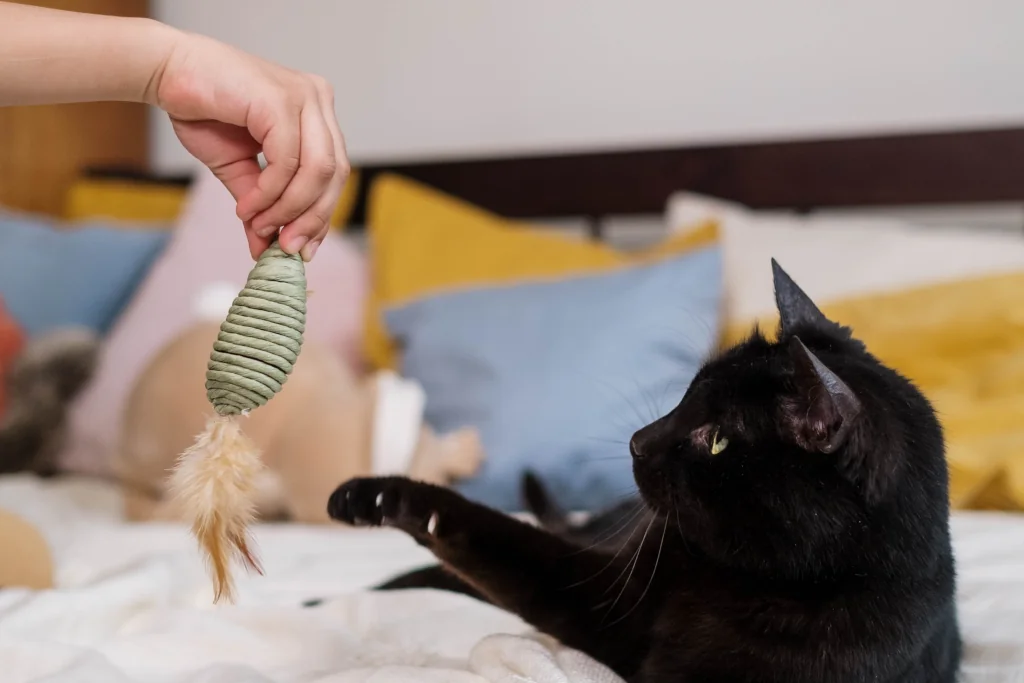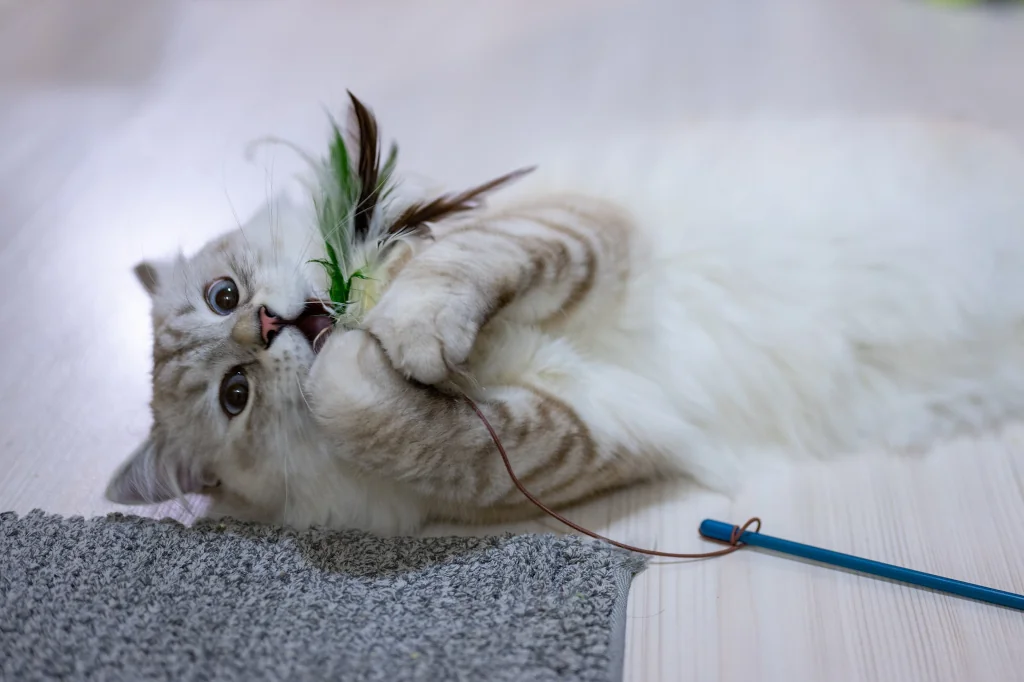Disclosure: We may earn a commission from helpful, relevant links in our content. No cost to you. See our privacy policy.
Ready to dive into the wonderful world of feline frolics?
It’s no secret that your little furball loves a good play session, but how can you ensure you’re keeping their interest piqued and their curiosity satisfied?
If you’re constantly finding untouched toys while your kitty lounges unamused, or if you’re struggling to coax a less-than-enthusiastic feline into playtime, we’ve got you covered.
Your journey into becoming the ultimate cat play connoisseur starts here.

Is Your Cat Bored? Recognizing the Signs
A bored cat isn’t just a cat lounging in a sunlit spot with half-closed eyes.
Sometimes, their boredom can manifest in a number of subtle ways that are easy to miss.
Your kitty might overeat or under-exercise, they might start acting out, or they might simply show a lack of interest in their surroundings. If your formerly curious cat now prefers to spend most of the day sleeping away, it’s likely time to reconsider your approach to playtime.
Remember, understanding your cat’s behavior is the first step towards reigniting their playful spirit.
Start With the Right Toys for Your Cat
One toy that’s a proven hit across the feline kingdom is the Laser Pointer.
Cats are natural hunters, and a laser pointer offers a fantastic way to engage those instincts. But remember to end the play session by pointing the light onto a tangible toy, as this helps your kitty enjoy the satisfaction of a ‘catch’.
The second cat toy that earns high marks in our list is the Interactive Feeder Toy. These toys serve a dual purpose: they stimulate your cat’s mind and control feeding for cats who might eat too quickly. Filling it with their favorite treats or kibble can ensure that your cat has a great time “hunting” their food, keeping them engaged and well-fed.
And lastly, let’s not forget about the classic Feather Wand. Feather wands mimic the movement of birds, which can trigger your cat’s instinctual drive to hunt. It’s a great way to interact with your cat and provide them with much-needed exercise.
By choosing and rotating between these toys, you’ll be providing your cat with a variety of exciting play options.
How to Encourage Play in Your Cat: Expert Tips
One of the most effective ways to kickstart play is to tap into your cat’s natural hunting instincts.
The Art of Imitation
Take it from me and my cat, Smokey. His eyes light up at the sight of a feather wand toy darting and swooping in front of him, mimicking the unpredictable movements of a bird in flight.
This type of play is a form of “prey imitation” and can get even the most lethargic kitty raring to pounce. Get your cat a feather wand, and you’ll see!
The Power of Scent
Did you know cats have a powerful reaction to certain scents? Using scent-based toys can help stimulate your cat’s interest.
Catnip, silver vine, and valerian are some scent options that can be a big hit with cats. Toys infused with these scents can encourage playful behavior. However, remember that not all cats respond to these scents, and their effects can vary.
For my cat Smokey, a whiff of catnip was enough to ignite his inner playfulness! Not sure which one to go for? Cats go nuts for this Crunchy Pickle Kicker!
Interactive and Puzzle Toys
Interactive and puzzle toys aren’t just fantastic for dogs; they’re also a great tool for encouraging play in cats. They not only engage your cat physically but also stimulate their problem-solving skills.
From treat-dispensing toys to food mazes, these playthings can keep your cat engaged and mentally stimulated. Just make sure the difficulty is well-matched to your cat’s skill level to avoid frustration.
Rotating Toys
Does your cat seem disinterested in their once-favorite toy? Don’t worry, it’s not you, it’s them!
Cats, like us, can grow bored of the same old routine. So, a simple trick I’ve found effective is toy rotation. Instead of leaving all toys out, try introducing one or two toys at a time, then rotate them out every few days.
This variety helps to maintain a sense of novelty and keeps the intrigue alive.
The Freedom of Choice
Sometimes, what works best is giving your feline friend the freedom to choose their playtime.
Leave a selection of toys out for them to discover and interact with on their terms. You might be surprised by what they’re drawn to.
Who knows? You might even find that your cat’s favorite toy isn’t a store-bought one, but a crumpled piece of paper or a stray bottle cap!
Remember, what’s most important is tuning into your cat’s unique preferences and adjusting your playtime strategies accordingly. When you listen to your cat and respect their choices, you help foster a deeper bond of trust, transforming playtime into a joyous experience for you both.

Can Older Cats Play Too? You’d Be Surprised
Contrary to what some may think, older cats aren’t destined for a life of endless napping. In fact, engaging in play can help keep your senior kitty physically fit and mentally sharp.
Of course, their style of play might look different than that of a young, energetic kitten.
Older cats may prefer slower, more thoughtful games, like a gentle batting session with a feather toy or a leisurely exploration of a puzzle toy. Remember, patience and understanding are key when engaging older cats in play.
How to Create a Play-friendly Environment for Your Cat?
Creating a play-friendly environment for your cat goes beyond simply scattering toys around your home.
Think vertical! Cats love to climb, so consider adding cat trees, shelves, or window perches to your space.
Variety is important too – try a mix of interactive toys, cuddly plushies, and puzzle toys to keep your cat intrigued.
Don’t forget about quiet spaces, as well – after a hearty play session, your cat will appreciate a comfy, secluded spot to nap and recharge.
FAQs
What should I do if my cat loses interest in its toys?
Try rotating your cat’s toys to maintain novelty, and consider adding scent-based or interactive toys to pique their interest.
How long should I play with my cat each day?
Aim for two 15-minute play sessions each day, although individual cats may prefer more or less playtime.
How do I encourage an older cat to play?
Encourage an older cat to play by providing slower, thoughtful games, using softer toys that are gentle on aging teeth and claws, and allowing them to play at their own pace.
Is there a specific time of day when cats are more likely to play?
Cats are crepuscular animals, meaning they’re most active during the dawn and dusk. So, these times are often when cats are most inclined to play.
Alex, a passionate animal lover, has experience in training and understanding animal behavior. As a proud pet parent to two dogs and three cats, he founded AnimalReport.net to share insights from animal experts and expand his knowledge of the animal kingdom.




